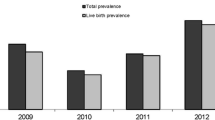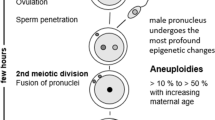Abstract
The epidemiological analysis of trisomy 21 presented for the new federal German state of Saxony-Anhalt describes trends and changes in the frequency of Down's syndrome and prevalences of the pregnancy outcomes including acceptance of prenatal diagnostic measures in the period from 1980 and with separate analysis for the period since reunification in 1990. The average prevalence in the entire period is 1.0 per 1000 births. In 1997, a prevalence of 1.7 per 1000 births was already observed. After 1990, there is an increase in the prevalence of conceptions with trisomy 21 whereas the prevalence of live births with Down's syndrome remained the same. The reasons for this are an increase in the age of the mothers and a broad acceptance of prenatal diagnostics. Ethical questions, that might for example reveal societal changes in the attitude to children with Down's syndrome have not been considered in the analysis, since this would require sociological investigations which cannot be carried out by the malformations register.
Similar content being viewed by others
References
Cuckle HS, Wald NJ, Thompson SG. Estimating a woman's risk of having a pregnancy associated with Down's syndrome using her age and serum alpha-fetoprotein level. Br J Obstet Gynaecol 1987; 94: 387-402.
Hook EB. Rates of chromosome abnormalities at different maternal ages. Br J Obstet Gynaecol 1981; 58: 282-285.
Tymstra TJ, Bajema C, Beekhuis JR, Mantingh A. Women's opinion on the offer and use prenatal diagnosis. Prenat Diagn 1991; 11: 893-898.
Renand M, Bouchard C, Kremp O. Is selective abortion for a genetic disease an issue for the medical profession? A comparative study of Quebec and France. Prenat Diagn 1993; 13: 691-706.
Central Office of Statistics Saxony-Anhalt (Annual publication).
Modell B, Kuliev AM. Impact of public health on human genetics. Clin Genet 1989; 36: 286-298.
Huether CA. Projection of Down syndrome birth in the United States 1979-2000 and the potential effects of prenatal diagnosis. Am J Public Health 1983; 73: 1186-1189.
Cornel MC, Breed AS, Beekhus JR, te Meerman GJ, Kate LP. Down syndrome: Effects of demographic factors and prenatal diagnosis in the future of live birth prevalence. Hum Genet 1993; 92: 163-168.
Mutton D, Ide RG, Alberman E. Trends in prenatal screening for and diagnosis of Down's syndrome: England and Wales, 1989-97. BMJ 1998; 317: 922-923.
Hoshi N, Hattori R, Hanatani K, et al. Recent trends in the prevalence of Down syndrome in Japan, 1980-1997. Am J Med Genet 1999; 84: 340-345.
Nicholson A, Alberman E. Prediction of the number of Down's syndrome infants to be born in England and Wales up the year 2000 and their likely survival rates. J Intellect Disabil Res 1992; 36(PT 6): 505-517.
Cuckle H, Nanchahal K, Wald N. Birth prevalence of Down's syndrome in England and Wales. Prenat Diagn 1991; 11(1): 29-34.
Reynier JC, Aurran Y, Dumarek A, Maron A, Chabal F, Grand F, Ayme's S. Attitudes towards Down's syndrome: follow up of a cohort of 280 cases. J Med Genet 1995; 32: 597-599.
Stone DH, Rosenberg K, Womersley J. Recent trends in the prevalence and secondary prevention of Down syndrome. Paediatr Perinat Epidemiol 1989; 3: 278-283.
Olsen CL, Philip K, Cross LJ, Hughes G, Hughes JP. The effects of prenatal diagnosis, population ageing, and changing fertility rates on the live birth prevalence of Down syndrome in New York State 1983-1992. Prenat Diagn 1996; 16: 991-1002.
Sipek A, Gregor V, Horacek J, Chudobova M. Down's syndrome in the Czech Republic 1961-1997. Ceska Gynekol 1999; 64(3): 173-179.
Huang T, Watt H, Wald N, Morris J, Mutton D, Alberman E, Kelekun C. Birth prevalence of Down's syndrome in England and Wales 1990 to 1997.J Med Screen 1998; 5(4): 213-214.
Christiansen M, Petersen PL, Permin M, Larsen LA, Norgaard-Pedersen B. Maternal serum screening for congenital abnormalities and Down syndrome in Sonderjylland County. Eight years of experience. Ugeskr Laeger 1999; 161(50): 6928-6934.
Huderer-Duric K, Skrablin S, Kuvacic I, Sonicki Z, Rubala D, Suchanek E. The triple-marker test in predicting fetal aneuploidy: a compromise between sensitivity and specificity. Eur J Obstet Gynecol Reprod Biol 2000; 88(1): 49-55.
Author information
Authors and Affiliations
Rights and permissions
About this article
Cite this article
Rösch, C., Steinbicker, V. & Kropf, S. Down's syndrome: The effects of prenatal diagnosis and demographic factors in a region of the eastern part of Germany. Eur J Epidemiol 16, 627–632 (2000). https://doi.org/10.1023/A:1007693025935
Issue Date:
DOI: https://doi.org/10.1023/A:1007693025935




